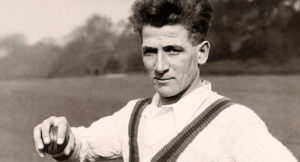Harold Larwood – A Real Sporting Hero!
[AdSense-A]

By Radical Rhymes
When I was young, I admired fast bowlers. For the cricket uninitiated these are cricketers who are able to propel a cricket ball, 5.75 ounces of rock hard leather, at 90mph+ at a batter 22 yards away. The pace, the athleticism, the danger, it was as exciting for me then as it is now. Take a look at dangerous fast bowling on
YouTube to get some insight.
There were so many to choose from. The West Indies had a whole platoon of them: Andy Roberts, Malcolm Marshall, Joel Garner, Colin Croft, and my favorite of them all, Michael Holding. His nickname was Whispering Death because he bowled like fire, and, his run up was so smooth that the umpires couldn’t hear him approaching.
Magnificent.
But my all-time fast bowling hero, a legend that the cricket establishment tried to destroy, was Harold Larwood. Where to begin? He possessed one of the most beautiful, poetic, rhythmic bowling actions in history. Maybe THE most beautiful. At a time when the game was split between gentlemen and players, he was a true player, as well as a gentleman.
And in a time of part-time professionalism, poor diets, inadequate equipment and limited facilities, he was fast, and I mean seriously quick. Experts have timed him using the available footage, and they estimate that he was bowling at 96mph! That seems almost impossible given that the fastest recorded delivery is 100mph by Shoaib Akhtar in 2003.
To put flesh on these statistical bones, there is a story that he was bowling at a batsman in county cricket once, when a telegram was delivered to him mid over. He read it quietly and then proceeded to bowl at the speed of light. One of the batsman he dismissed asked one of the fielders what the telegram had said. Apparently, it was news that his wife had given birth. The disgruntled batter said: Thank God it wasn’t twins!
There are a host of such tales.
Harold represented Nottinghamshire and England, and he played during the period that the Australian, Sir Donald Bradman, the greatest batsman in history, was dominating every bowling side on the planet. To finish with an average in the 40s is considered brilliant in test (5-day international) cricket. Bradman averaged 99. He was single-handedly responsible for English cricketing nightmares.
How to stop him though? Facing a tour to Australia with the Don in his prime in 1932-33, the newly appointed England captain, Douglas Jardine needed a plan. After spending hours watching reels of film, he finally found something. Short pitched bowling. The Don looked uncomfortable against fast bowling aimed into the body.
He assembled, with Harold as his spearhead, a battery of fast bowlers to intimidate and bully the Australians into submission. When they arrived in Oz to begin the tour they were asked by journalists what sort of team they’d brought. They were told that if they didn’t beat the Aussies, they’d ‘knock their bloody blocks off’. That was not so far from the truth.
What followed nearly caused a diplomatic incident. Jardine had invented what he called Leg Theory, but which is more commonly known as Bodyline. The tactic was simple. Surround the batsman with close in fielders on the leg side and bombard them with short pitched bowling. It worked. Not only did the Don’s average fall to just over 50, but England won the series against all odds.
And it worked in large part because Harold was so fast and so incredibly accurate. Later Bradman accused him of throwing, but that was just sour grapes. Larwood was a bowling genius bowling to a genius batsman. There was enormous anger, there were bumps, bruises and broken bones. And, initially at least, there was jubilation. The Ashes were coming home!
However, the celebrations didn’t last. The England team were called cheats, branded unsporting, and worst of all, they were accused of placing winning above the spirit of the game. Even where cricket isn’t played much, the term ‘it just isn’t cricket’ has some meaning.
The establishment were embarrassed. They couldn’t possibly blame Jardine, he was a gentleman, so they chose the fastest and greatest bowler we’d ever had to be the scapegoat. Harold was just a player, a coal miner, he was the perfect sacrificial lamb. He was called to Lords – the home of cricket – to apologize.
After bowling himself into early retirement on the rock hard Australian pitches, bowling until his feet were a bloody mess, after bringing home the greatest prize in the game, Larwood was cast to the wolves. But, in true heroic fashion, he refused. If he apologized, he said, his mother would kill him. As a result, he became an outcast, a persona non grata in the game he loved.
He left cricket and opened a sweet shop, but his heart was genuinely broken. Eventually, with the encouragement of Jack Fingleton, one of the batsman he’d peppered in 1932, he left the UK to live out his days in Australia. Harold lived there happily with his family, where he was treated as a pilgrimage for touring English cricketers, and especially the fast bowlers. The place where he was most reviled became his final home.
Yes, I loved Harold and always will. He was more than a fast bowling or cricketing legend, he was a man who stood up to the class bullies that ran the game. He was, and always will be, a genuine, cast iron, hero.
Thanks our ‘arold!
Radical Rhymes is a professional artist working with a range of media – predominantly animal/human portraits and landscapes – including, most recently, hand painted furniture. You can see his work on Instagram Radicalrhymes1969 or on Twitter @RhymesRadical.
For commissions, please contact him on Twitter via Direct Message or by email at: radicalrhymes@outlook.com His work is also available to buy on Etsy
[si-contact-form form=’2′]

